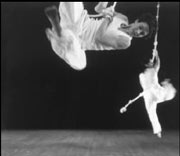RIGGED
Velocity MainSpace Theater, 915 E. Pine, second floor, 781-7746, $12-$14 8 p.m. Fri.-Sun. runs Fri., Oct. 4-Sun., Oct. 13
MOST DANCERS GET ready for a new work by taking class and doing some aerobics or weight training; for their upcoming show, Rigged, the members of d9 Dance Collective went outside and climbed some trees. It was preparation for the ropes from which they’ll swing during Lisa Race’s sextet “Tether.”
Race, a New York-based choreographer, makes the kind of big, physical dances for which Seattle’s d9 has become known over the last 10 years. In addition to her background in modern dance and contact improvisation, you can see hints of gymnastics in her work—the performers spend a considerable amount of time upside down or backside front, with hands taking the place of feet to support their weight. Leaving the floor was the next logical step.
“I wanted to see what it would be like to really fly,” says Race.
The “flying” in the piece is as much about endurance as exhilaration: Unlike some aerial work that de-emphasizes the effort, you actually see the muscle it takes to lift oneself onto a rope or a trapeze. The pendulum swing of the rope is disturbed, jerked aside when it shudders into a new direction as the dancers lever themselves into a sequence of positions. You hear the creak of the rope as it stretches, the groan of metal in the rigging. In combination with the suggestion of bells in the music score, the dance resembles the workings of a boat; the end, with the performers caught up in their ropes like fish in a net, reinforces that image.
When Race first made the work for a quartet in 1994, she had difficulty finding a rehearsal space where she could set up her equipment. Most studios didn’t have the beams or pipes in the ceiling that could support the dancers’ weight, so she wound up slipping into theaters after hours. The challenge of equipment has been an issue for d9’s production as well. Company member Michelle Miller saw the dance several years ago and wanted to bring it to Seattle then, but it’s only this year that the Velocity space installed the additional pipes in the ceiling needed for the performance.
In addition to “Rigged,” d9’s 10th- anniversary program will include “Incognito,” a new piece by Ecuadoran-born choreographer Pablo Cornejo, and KT Niehoff’s light-hearted “White Girls,” with music by Amy Denio.
D9 CHOSE “TETHER” the same way it has acquired all of its repertory over the last decade—at the request of its members. Unlike most dance companies, in which a choreographer or director makes decisions, the members of d9 make artistic choices themselves. As a collective, the group shares responsibilities, resulting in a process that’s filled with meetings (“Sometimes more meeting than dancing,” Miller admits).
This “direction by democracy” aesthetic has brought some exciting choreography to Seattle: dances by Gregg Bielemeier, Joy Kellman, Bebe Miller, and Donna Uchizono, as well as commissioned work by many local artists. Sometimes, though, this smorgasbord approach to programming seems too broad, and you wonder what the company might accomplish if it had an overarching mission. The group considered rotating the artistic direction among the members but finally rejected the idea. After several experiences in other companies where decisions were made for them, says Miller, the dancers feel strongly about keeping that control for themselves, so the independent nature of the group is reflected in its programming.
The traditional dance company structure, with performers as acolytes and directors as leaders, has been shifting for many years. Dancers work in several different ensembles and choreographers job out for individual projects. But d9 has taken a giant step along that continuum. In a world of independent contractors, perhaps its mission will become the standard structure. For a troupe that has set a chunk of dance history on its head, it must seem appropriate to perform upside down.









